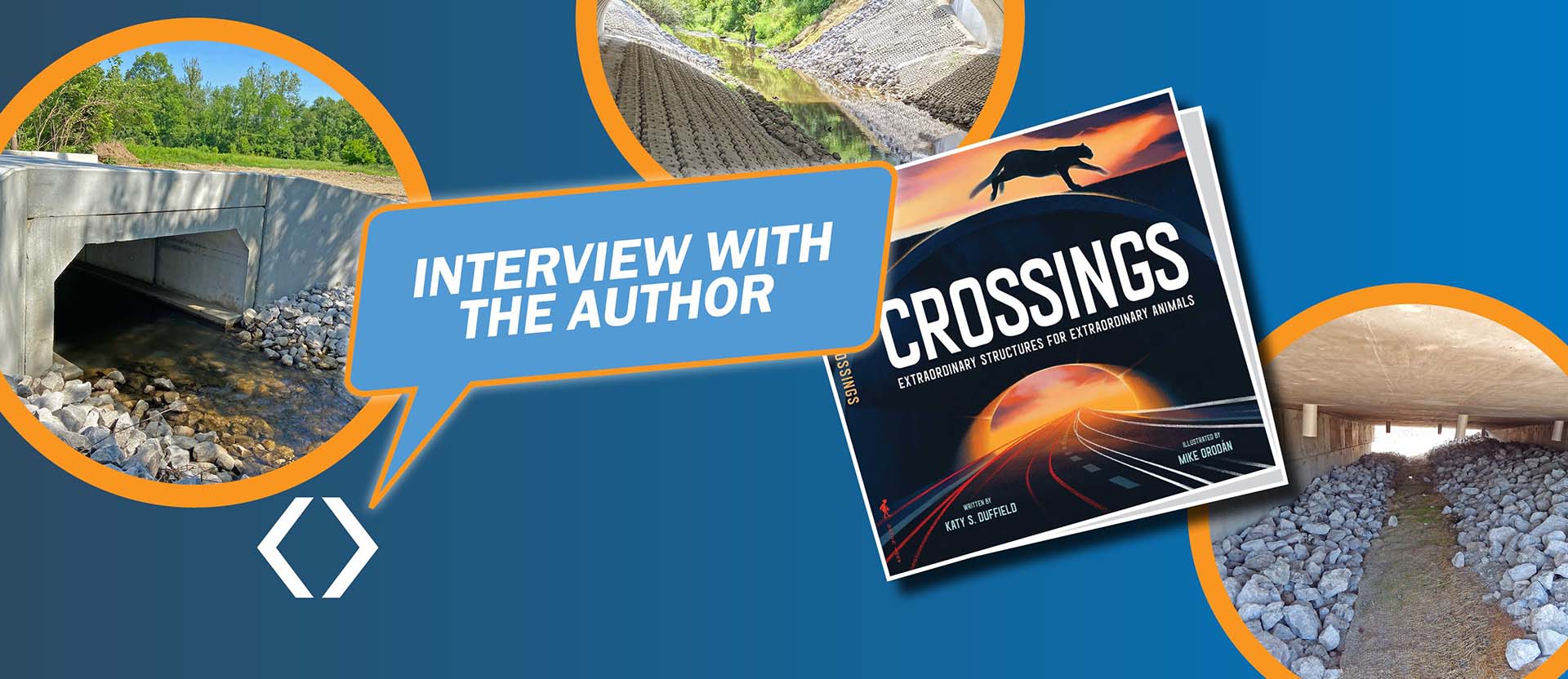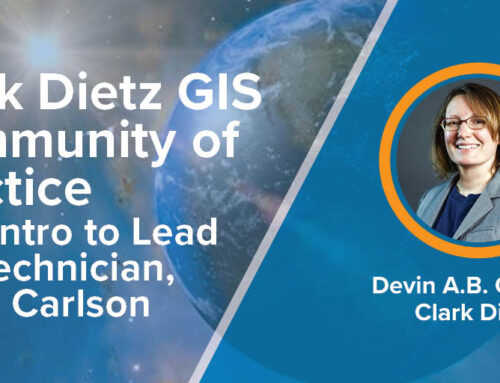Clark Dietz’s Kevin Hetrick, PE, was recently featured in Civil + Structural Engineer magazine. In the article, Kevin interviewed Katy Duffield, Children’s Author of Crossings, which explores the how wildlife crossings are designed and engineered to keep animals safe. Her message on conservation and safety (which extends animals and people alike), is one we strongly support. While we were only able to use a portion of Kevin’s Interview with Katy in the article, we have included the entire conversation below:
Have you always been interested in environmentalism? What caused your interest?
For as long as I can remember, I’ve been an “outdoors” person. As a girl, I stayed outside as much as possible and was always interested in nature and animals. I picked up and checked out every insect I could find, threw tennis-ball-filled socks in the air to attract bats, waded in streams, felt tadpoles wriggle in my palms, caught crawdads with a paperclip, a string, and some bacon, was mesmerized by the lights of fireflies, and the sounds of whippoorwills and bob whites.
Along with my love for nature, my love for animals has always been strong. I feel a deep connection with them and never want them to be mistreated. As an adult, I’ve enjoyed watching and photographing animals—including the birds, deer, coyote, and foxes that occasionally visit our backyard.
When was the first time you encountered the subject of wildlife crossings?
When I lived in Florida, I ran across an online newspaper article about underpasses that had been built in the state to help endangered Florida panthers safely cross beneath busy highways. I found that fascinating! I knew the panthers were endangered and that development encroaching on their habitat was a problem. I also knew that they were dying at an alarming rate because they were being hit by cars as they crossed busy roads. I was excited to learn that these novel and ingenious underpasses might help save these beautiful animals.
And the panther underpasses got me thinking: are there any other wildlife crossings in the U.S. or in the world? So, I began researching and was amazed to find that there are—for creatures of all shapes and sizes–and I immediately knew I wanted to write about them. The animal lover in me felt that young animal lovers would enjoy learning about these crossings, too.
What did your research look like when writing Crossings?
The majority of my research was done online. I would have loved to have visited all the places where these crossings exist and see the animals using them firsthand, but that wasn’t possible since they are so widespread and found all over the world—and some are off-limits to the public. So, I began scouring the internet for articles to learn everything I could about various crossings. Online videos (YouTube) were also a great research source as several parks, news organizations, DOTs, and others posting videos of animals using the crossings. They are fun to watch, as you never know what animal you might see next! Some of these videos are posted on my website.
What do you consider when writing for a young audience when it comes to this topic?
As I previously mentioned, I thought the topic would be perfect for young readers because many young people enjoy reading about animals, and because it covers a topic that many of them (like me) had never heard of.
I wanted Crossings to have a tight, lyrical feel that would appeal to very young readers, but I also wanted to include more detailed information to interest to older readers, too. Hopefully, the “over, under” repetition draws in the youngest readers and sounds pleasing as it is read aloud, and the embedded layered text provides additional information for older readers who want to know more.
I did have some concerns about the “roadkill” aspect—especially for the youngest readers—but I think illustrator, Mike Orodán, handled that so well in the art. The threat to the animals from the cars is certainly visible, but the animals remain safe.
I also wanted to highlight the creators of the crossings—the “animal lovers”, like the scientists who study where the crossings will be most effective, the architects and engineers who draw up the actual structures, the construction workers who do the on-site building of the structures, and others who are instrumental in making these crossings happen. And when I read about the Kids Saving the Rainforest organization and their blue ropes for the monkeys, I knew I’d found an important facet that would show young readers that even at their ages, they could also make a difference.
What would you like kids (and families) to take away from the message after reading Crossings?
First, and foremost: Animals are IMPORTANT. I firmly believe that everything in nature is interconnected—from the tiniest insect to the largest mammal. Every creature plays a distinct role, and we need every single species.
Secondly, thinking outside of the box is a great way to come up with viable solutions to problems.
Thirdly, putting our hearts and our minds together, we can solve problems. Everyone can contribute. Everyone can make a difference.
Are you optimistic about future focus on the interaction between humans and wildlife as it relates to infrastructure?
I’m hopeful. I am continuing to read articles that come out on the topic of wildlife crossings. I feel that others are beginning to see their importance and are beginning to be willing to invest in them. I certainly hope that these crossings and other wildlife protection projects will continue to expand throughout the world.
We liked that you included a wide variety of animals using different types of crossings. Our wildlife crossing projects are often attached to new infrastructure for humans and motorists and include a “shelf” underneath the structure for smaller critters like racoons and rodents. We feel strongly that while the big projects may garner the most national attention, the ecosystem depends on our service to the wildlife in our own geographical environments. How would you recommend people advocate for wildlife conservation in their own communities?
I love hearing about big projects, like the forthcoming Wallis Annenberg Crossing in California, but I’m also encouraged by smaller, local efforts. I live in Arkansas, and most of our crossings here are also on the smaller side—”shelves” that provide walkways for smaller animals like raccoons and opossums, and gravel “benches” in culverts that benefit white-tailed deer.
If you aren’t aware of any wildlife crossings in your area, I would contact your local department of transportation. Ask if any crossings exist in your area and if any proposed crossings are forthcoming.
Also, learn as much as you can about animals native to your area. Are some of them classified as threatened or endangered? Research to see what is being done to help those animals. Go online to find local organizations that are trying to help. Is there anything you can do (no matter how small) that could help?
Related to the previous question we asked how you think people can advocate for wildlife conservation in their communities. What would you recommend for parents to teach their children about wildlife conservation beyond your book?
To help children understand the importance and interconnectedness of nature, spend time outdoors with them. Turn over rocks or rake back leaves to see what’s there. Carefully examine insects you find, watch birds through binoculars, plant a pollinator garden, add a small water source to your backyard, take a hike, or hang a bird feeder. It’s all about teaching young people to enjoy nature and raising their awareness about its importance from an early age.
The main argument against Wildlife Crossing bridges is that these infrastructures can be expensive. Are there any alternative wildlife conservation strategies related to infrastructure that you believe the public/government should be aware of? If so, what are they, and how would they contribute to conservation?
The large projects are incredibly expensive, but I think these larger projects that get a lot of press can be a great way to raise awareness for crossings in general. They may prompt the public and other governmental bodies to look at ways to protect the animals in their areas—even if it is not on such a grand scale. It comes down to doing what we can to raise awareness across the board; look to see where the problems arise and figure out ways to remedy them. And it doesn’t just have to be crossings—creating wildlife corridors, making pollinator paths or “bee highways, for example, can go a long way in keeping insect and animal populations strong.
We need to remember, too, that these expensive crossings benefit people. Keeping large animals off the roadways prevent their deaths, but can also protect human lives. Cars striking animals cause many human casualties and cause an enormous amount of property damage each year. Wildlife crossings are a win for animals and for people.
Anything else you’d like to share on the topic?
I’ve connected with many teachers and librarians since Crossings came out and I’ve been honored and thrilled to see how they are using the book in their classrooms. Many educators have shared with me how they’ve had their students design and build their own crossings in the classrooms using cardboard tubes, blocks, Legos, magnet tiles, etc. Once their creation is complete, many have used plastic animals to demonstrate how their inventions work. So many wonderful, imaginative solutions!
Also, I can’t talk about the book without mentioning Mike Orodán’s amazing art. I was thrilled to be paired with him for the book. His illustrations brought the gorgeous animals to life and added an endearing layer to the text!
Finally, there are so many wonderful nonfiction picture books being produced right now. I’d encourage parents to seek out other books about animals and conservation. One in particular, that is related to wildlife crossings that might be of interest is Cougar Crossing written by Meeg Pincus and illustrated by Alexander Vidal.





